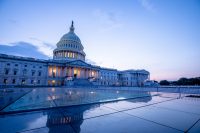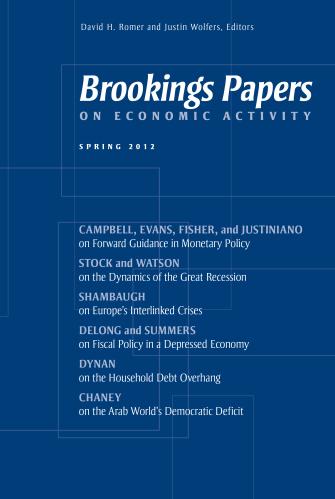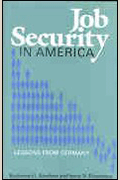Last week, Hamilton Project Director Jay Shambaugh outlined the components to a fiscal response to the COVID-19 pandemic and on Sunday night, House Speaker Nancy Pelosi and Senate Democratic Leader Chuck Schumer released their list. Many of the policy proposals put forth in the Hamilton Project and Washington Center for Equitable Growth volume, Recession Ready: Fiscal Policies to Stabilize the American Economy, make the list.
Increasing food purchasing power should be a central part to any stimulus package; the Supplemental Nutrition Assistance Program (SNAP; formerly the Food Stamp Program) is an incredibly effective automatic stabilizer. In this piece, we briefly detail policy responses tailored to the pandemic to support food security, particularly for households with children. While the Trump Administration has signaled some flexibility, for example in granting waivers to allow for meals to be served in the event of a school closure, much more needs to be done to ensure that the food safety net kicks in.
First, there should be Congressional action to support SNAP benefit expansions, through increases to maximum benefit levels overall and for households with children. Specifically, Congress can act to:
- Immediately Increase SNAP Maximum Benefit Levels. In Recession Ready, Hilary Hoynes and Schanzenbach propose a 15 percent increase to the maximum benefit when the Sahm recession indicator (the 3-month average national unemployment rate rises at least 0.5 percentage points above its low of the previous 12 months) is triggered. Tying a SNAP benefit increase to the Sahm rule as part of a package designed to improve automatic stabilizers still makes sense. But in the specific circumstance in which we find ourselves, in which the public is being asked to prepare for widespread quarantine to combat community spread, Congress should increase resources to purchase food. Increase the SNAP maximum benefit by at least 15 percent, effective immediately.
- Immediately Introduce a SNAP Young and School-Age Child Multiplier. The Trump Administration has signaled a willingness to grant waivers that allow eligible entities to continue to serve meals when schools are closed. But in the event of ongoing acute and seasonal schooling disruptions, Congress should consider introducing a multiplier of 20 percent to the maximum SNAP benefit for households with young (0-5 years old) and school-age (6-18 years old) children. Details and evidence supporting the child multiplier can be found in a Hoynes and Schanzenbach policy proposal for Equitable Growth. In addition, Congress could codify Summer EBT (a summer food stipend for children eligible for free and reduced-price school meals in a manner similar to SNAP) with an additional trigger that allows for these benefits to flow during the school year in the event of an emergency, including school closures and community quarantines that result from public health emergencies. Augmented Summer EBT could be a mechanism to provide resources to purchase food at time of predictable (summer) and unpredictable (emergency) need.
Second, Congress should take steps to maintain eligibility in both SNAP and school meal programs. Last week, the U.S. District Court heard arguments in a lawsuit regarding SNAP work requirements that more than a dozen states and localities filed to stop the Trump Administration from removing hundreds of thousands of people from SNAP rolls and weakening the ability of the program to respond to economic downturns. The Trump Administration has put out a proposal to revise broad-based categorical eligibility (cat-el), the subject of a recent House Committee on Oversight and Reform hearing, on the heels of the Supreme Court upholding the controversial “public charge” rule. With an April 1 effective date for the SNAP work requirement waiver final rule looming and actions pending on cat-el and public charge, Congress can act to:
- Immediately Waive SNAP Work Requirements Nationwide. As was done in the Great Recession through the American Recovery and Reinvestment Act, Congress should implement a SNAP work requirement waiver nationally, effective immediately. This will allow the program to expand and maintain eligibility among program participants in the event of both employment loss and the loss of hours that result from this public health crisis and/or an economic downturn.
- Legislate Economic Condition–Based Triggers to Waive Work Requirements. During the Great Recession, statewide waivers were granted when a state qualified for Extended Benefits to Unemployment Insurance (EB). The Bush and Obama Administrations further clarified that states that were eligible for a particular tier of Emergency Unemployment Compensation (EUC) also qualified for a state-wide work requirement waiver. Given that the Trump Administration (through the regulatory process) has stated that qualifying for EB no longer triggers such a waiver, it is reasonable to assume that this administration would not take the same position as the Bush and Obama Administrations with regard to EUC-based waiver eligibility. Congress should therefore clarify continuing state-wide waiver eligibility tied to the UI trigger system, both EB and EUC if authorized. Any sunset date for a work requirement waiver should be at least one fiscal year beyond the last UI system-tied trigger. Additionally, Congress should reinstate the 20 percent rule without an unemployment rate floor.
- Maintain State Flexibility for Categorical Eligibility; At Minimum Delay Public Charge. Congress should maintain support for cat-el, i.e. state flexibility in tailoring income and asset limits to SNAP. As part of a COVID-19 response that protects the most vulnerable, States have asked to delay the public charge rule.
To alleviate economic hardship and stimulate the economy during this time of uncertainty, we should provide additional resources to improve food security and maximize the reach of these programs. The concrete policy ideas put forth in this piece are evidence-based proposals that would improve household and child food security while supporting macroeconomic stability in response to the COVID-19 pandemic.











Commentary
Food security is economic security is economic stimulus
March 9, 2020